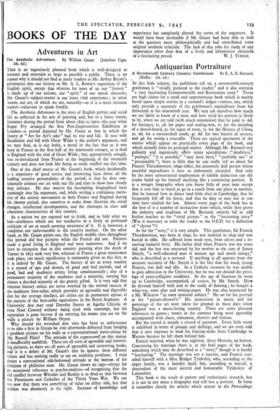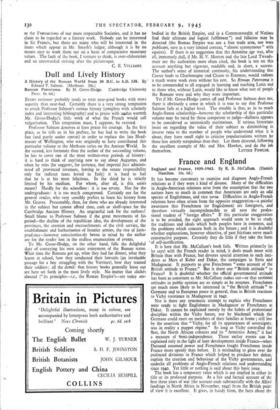Antiquarian Portraiture
A Seventeenth Century Country Gentleman. By E. A. B. Barnard. (Heifer. 10s. 6c1.)
IN this little volume, the publishers tell us, a seventeenth-century
gentleman is "vividly pictured to the reader," and it also contains "a very fascinating Commonwealth and Restoration story." These are high claims for a small and unpretentious book which is mainly based upon simple entries in a steward's ledger—entries, too, which only provide a summary of the gentleman's expenditure from his thirteenth to his nineteenth year. We may ask ourselves how much we are likely to know of a man, and how vivid his portrait is likely to be, when we are told (with much annotation) that he paid is. 6d.
for lozenges, is. zd. for paper and sealing-wax, Is. for the mending
of a shovel-board, 2S. for sugar of roses, 7s. for the History of China, 2S. 6d. for a tortoiseshell comb, 4s. 8d. for two barrels of oysters,
and 4d. for seeing a crocodile. These are typical specimens of the entries which appear on practically every page of the book, and which actually form its principal matter. Although Mr. Barnard very gallantly and ingeniously offers many speculations (" doubtless," "perhaps," "it is possible," "may have been," "probably not" or "presumably "), there is little that he can really tell us about Sir Francis Throckmorton (164o-168o), the _extremely dull person whose youthful expenditure is here so elaborately recorded. And only by the most unwarranted employment of nimble deduction can the reader build up for himself anything like a convincing portrait. It is a meagre biography when you know little of your man except that it cost him so much to go in a coach from one place to another, that he learned how to dance (and little else) at Cambridge, that he frequently fell off his horse, and that he may or may not at one time have studied the law. Almost every page of the book has at the foot of it a number of instructive notes which, while they prove the industry and erudition of Mr. Barnard, entirely fail to add livelier touches to the "vivid picture" or the "fascinating story." (Was it necessary to refer the reader to the O.E.D. for a definition of " clyster "?) As for the "story," it is very simple. This gentleman, Sir Francis Throckmorton, was born in 1640, he was married in 1659 and was buried in 1680. He suffered from weak eyes, from ulcers and a re curring malarial fever. His father died when Francis was ten years old, and the boy was entrusted by his mother to the care of James Smyth, "a well-educated man of mature age and much energy," who is described as a steward. If anything at all appears from the accurate accounts of Mr. Smyth it is the fact that his ward, young Francis, was dull and idle. As a Catholic recusant he was unable to gain admission to the University, but he was not denied the privilege of extra-collegiate residence. At the age of fourteen he went up to Cambridge, accompanied, of course, by Mr. Smyth. Here he devoted himself with zeal to the study of dancing ; he bought a whip-top, some glue and writing-paper. He was also instructed by a Mr. Wiborow "in some unstated subject." He sat for his portrait at the "picture-drawer's." His instruction in music and his patronage of the art were taken for granted in those days when England was a music-loving country. There are some pleasant references to games ; tennis in the summer being most agreeably accompanied with claret, cinnamon, cherries and lemons.
But the record is mainly a record of payment. Every little event is exhibited in terms of pounds and shillings, and we are even told that it cost sixpence to send his fencing-sticks from Cambridge to Weston because he left them behind him.
Francis married, when he was eighteen, Anne Monson, an heiress. Concerning his marriage there is, in the final pages of the book, something which may be described as a "story," though it is hardly "fascinating." The marriage was not a success, and Francis consoled himself with a Miss Bridget Tyldesley, who, according to the angry family, was a laundry naaid, but, according to herself, a descendant of the most ancient and honourable Tyldesleys of Lancashire.
This book is the result of patient and enthusiastic research, but it is not in any sense a biography and still less a portrait. In form it resembles closely the articles which appear in the Proceedings
or the Transactions of our more respectable Societies, and it has no claim to be regarded as a literary work. Nobody can be interested in Sir Francis, but there are many who will be interested in the items which appear in Mr. Smyth's ledger, although it is by no means easy to work them out on a basis of? comparative monetary values. The fault of the book, I venture to think, is over-elaboration and an unrewarded striving after the picturesque.
C. E. VULLIAMY.























 Previous page
Previous page